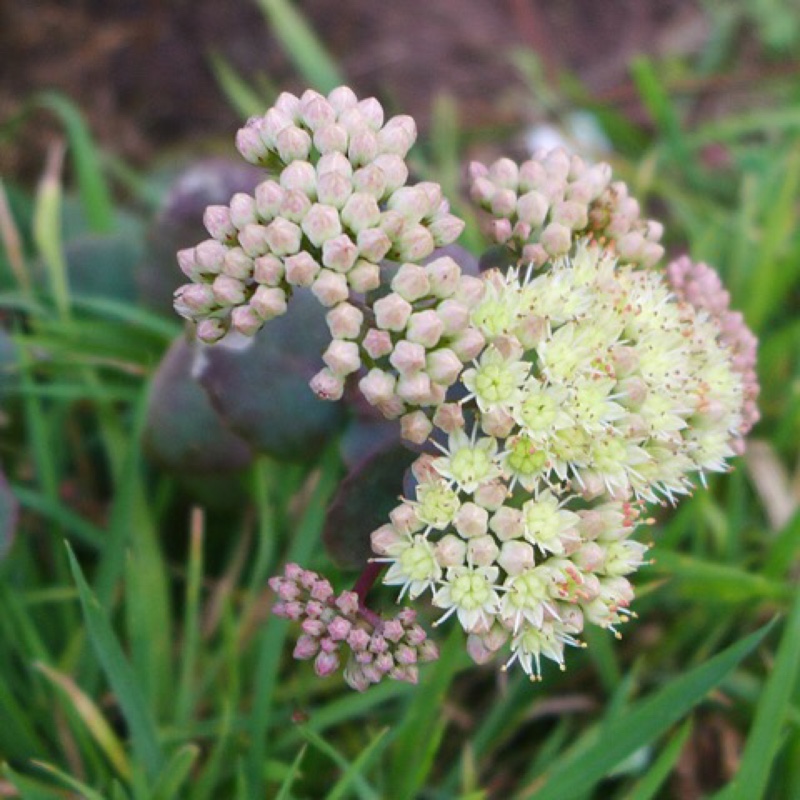
Hylotelephium Telephium sup. Ruprechtii
Hylotelephium 'Hab Gray'
http://www.crassulaceae.ch/de/artikel?akID=66&aaID=2&aiID=T&aID=2281 Synonyms : Sedum telephium ssp. ruprechtii Jalas (1954) / Sedum maximum ssp. ruprechtii (Jalas) Soó (1963) / Sedum ruprechtii (Jalas) Omelczuk (1978) / Hylotelephium maximum ssp. ruprechtii (Jalas) Dostál (1984) / Hylotelephium ruprechtii (Jalas) Tzvelev (1993) Sedum telephium var. petraeum Ruprecht (1860) Sedum polonicum Blocki (1897) / Hylotelephium polonicum (Blocki) Holub (1983) Sedum telephium var. stepposum Borissova (1939) Sedum stepposum Borissova (1970) / Hylotelephium stepposum (Borissova) Tzvelev (1991) Distribution : North-eastern Europe. Differs from ssp. telephium : Flowering stems decumbent or procumbent, 15 - 40 cm. Leaves opposite, suborbicular, glaucous-pruinose, dentate or subentire, base cordate-amplexicaul. FIowers whitish. Ray Stephenson (Sedum, Cultivated Stonecrops, 1994, pp 275 - 276) : Only available in recent years, Hylotelephium telephium ssp. ruprechtii is still a rare plant in cultivation and perhaps not yet available outside Europe. Rising, arching, then falling, stems, to about 30 cm (12 in) long, carry opposite-decussate, almost round leaves, which are lobed like the shape of a heart (cordate) and wrapped around the stem (amplexicaul) (Leaf shapes, fig. 1l). Glaucous blue-green leaves are tinged red on the margins, which range from almost entire to quite deeply toothed on the same plant. Habitat : Northeast Europe is the home of this stonecrop - chiefly in the Russian common-wealth on riverbanks and in meadows. Main points of distinction : Cordate, amplexicaul, suborbicular leaves are the best indicator though, as this plant is only available from specialized growers, it is likely to be correctly named. It is surprisingly similar vegetatively to Hylotelephium caucasicum, another Russian member of Hylotelephium that has more-cupped leaves (Leaf shapes, fig. 1a) and short, reflexed carpel beaks. Beaks of Hylotelephium telephium ssp. ruprechtii are long, straight, and hard. Perhaps it is only a matter of time before hybrids between this and promiscuous Hylotelephium telephium ssp. maximum confuse the situation. 2n = 48. Variation : Plants in cultivation probably have been vegetatively propagated from the same group of herbs and therefore will be pretty constant. Upper, smaller leaves tend to be sharply serrated while lower leaves tend towards being entire. Translucent, vaguely carinate, creamy-white petals in full sun can show pink edging (color of the buds). Horticulture : This is a pleasing subject for the front of a border or large rock garden. I expect it will become a plant for hanging baskets or urns, as the long, tumbling stems, carrying delightfully colored leaves, are most attractive.
Contributed by @gardentagssucculentexpert
-
Full sun to partial shade
-
Frequent watering
-
A little frost hardy: 32F (0°C)
-
Free draining and fertile
Common name
Hylotelephium 'Hab Gray'
Latin name
Hylotelephium Telephium sup. Ruprechtii
type
Succulent
family
Crassulaceae
ph
6.0 - 7.5 Acid - Neutral
Plant & bloom calendar
-
Best time to plant
-
When the plant will bloom
full grown dimensions
 0.45 M
0.30 M
0.45 M
0.30 M
Hylotelephium Telephium sup. Ruprechtii
http://www.crassulaceae.ch/de/artikel?akID=66&aaID=2&aiID=T&aID=2281 Synonyms : Sedum telephium ssp. ruprechtii Jalas (1954) / Sedum maximum ssp. ruprechtii (Jalas) Soó (1963) / Sedum ruprechtii (Jalas) Omelczuk (1978) / Hylotelephium maximum ssp. ruprechtii (Jalas) Dostál (1984) / Hylotelephium ruprechtii (Jalas) Tzvelev (1993) Sedum telephium var. petraeum Ruprecht (1860) Sedum polonicum Blocki (1897) / Hylotelephium polonicum (Blocki) Holub (1983) Sedum telephium var. stepposum Borissova (1939) Sedum stepposum Borissova (1970) / Hylotelephium stepposum (Borissova) Tzvelev (1991) Distribution : North-eastern Europe. Differs from ssp. telephium : Flowering stems decumbent or procumbent, 15 - 40 cm. Leaves opposite, suborbicular, glaucous-pruinose, dentate or subentire, base cordate-amplexicaul. FIowers whitish. Ray Stephenson (Sedum, Cultivated Stonecrops, 1994, pp 275 - 276) : Only available in recent years, Hylotelephium telephium ssp. ruprechtii is still a rare plant in cultivation and perhaps not yet available outside Europe. Rising, arching, then falling, stems, to about 30 cm (12 in) long, carry opposite-decussate, almost round leaves, which are lobed like the shape of a heart (cordate) and wrapped around the stem (amplexicaul) (Leaf shapes, fig. 1l). Glaucous blue-green leaves are tinged red on the margins, which range from almost entire to quite deeply toothed on the same plant. Habitat : Northeast Europe is the home of this stonecrop - chiefly in the Russian common-wealth on riverbanks and in meadows. Main points of distinction : Cordate, amplexicaul, suborbicular leaves are the best indicator though, as this plant is only available from specialized growers, it is likely to be correctly named. It is surprisingly similar vegetatively to Hylotelephium caucasicum, another Russian member of Hylotelephium that has more-cupped leaves (Leaf shapes, fig. 1a) and short, reflexed carpel beaks. Beaks of Hylotelephium telephium ssp. ruprechtii are long, straight, and hard. Perhaps it is only a matter of time before hybrids between this and promiscuous Hylotelephium telephium ssp. maximum confuse the situation. 2n = 48. Variation : Plants in cultivation probably have been vegetatively propagated from the same group of herbs and therefore will be pretty constant. Upper, smaller leaves tend to be sharply serrated while lower leaves tend towards being entire. Translucent, vaguely carinate, creamy-white petals in full sun can show pink edging (color of the buds). Horticulture : This is a pleasing subject for the front of a border or large rock garden. I expect it will become a plant for hanging baskets or urns, as the long, tumbling stems, carrying delightfully colored leaves, are most attractive.
Flowering
From Mid Summer TO Mid Autumn
Most sedum flower through the summer months and into early Autumn
Planting
From Early Spring TO Mid Spring
Plant divisions or seeds in Spring
Propagating by seed
From Early Spring TO Mid Spring
Sow seeds in Spring
Propagating by division
From Mid Spring TO Late Summer
Dividing plants for propagation can be done at any time during the growing season, and divisions will grow readily.
Propagating
From Early Spring TO Late Winter
Hylotelphium will grow roots from stems wherever it comes in contact with soil. Break off a piece, leave it for a day or two to rest and callous over, then stick it in the soil and wait for roots.











